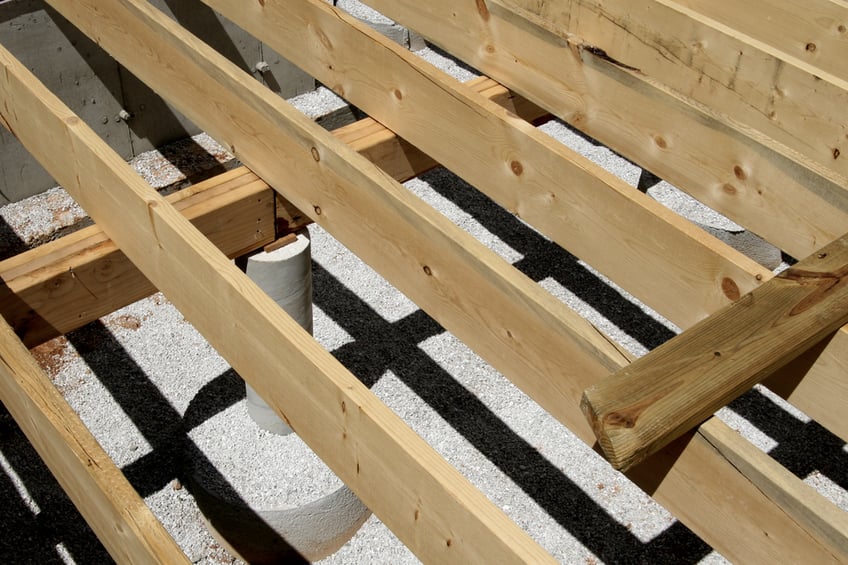Foundation construction is not considered one of the most exciting aspects of the construction industry; however, they are vital to the overall structural integrity of a building. There are two different types of foundations, including concrete slabs and stumps which establish the floor structure of buildings.
Compare foundation options
Benefits of concrete slab foundations
Slab foundations are large solid expanses of poured concrete that contain reinforcing materials such as steel mesh and reinforcing rods. The slab can be a sub-floor and floor foundation, with other flooring finishes laid on top. Flooring material rests on top of the concrete slab , some materials include timber floors, tiles and carpets. The slab below the flooring creates an effective moisture barrier for the foundation of a building that is affordable and durable.
Depending on the site and soil requirements, there are a number of different slab designs available for house foundations at a construction site. The soil must be compacted before a concrete slab can be poured to ensure the stability of the building and to minimise cracking. Concrete slab foundations are generally known to achieve a higher satisfactory energy rating due to providing more insulation. Buildings built on a concrete slab foundation are generally considered to be more solid and less susceptible to movement due to being a strong base material. They also provide a protective barrier against burrowing insects and termite infestation.
Benefits of building on stumps
In the past, many homes were traditionally built on timber or concrete stumps with timber bearers. Building on concrete stumps involves a sub-floor of horizontal bearers (beams) that support joists. The timber bearers sit on stumps which are adjusted in length to all be level with each other. Concrete stumps and subfloor framing is very labour-intensive process during the construction process. Being built on stumps requires careful attention to insulate a subfloor to a satisfactory energy rating. Due to being raised off the ground more insulation is needed to achieve a satisfactory energy rating, with taller stumps requiring more cladding materials around the perimeter of the building.
However, stumps are a great foundation option for buildings that are raised above ground level. Traditional stumps can be used for any degree of site slope which provides safety against flooding. As Australia is known to experience both droughts and flooding, it is essential to know if a building is being constructed in a flood-prone area as concrete stumps would be recommended. Buildings on stumps can be easily adjusted while providing easy access to drainage systems, making pumping problems easy to fix. Renovations and extensions are also easy to complete with buildings built on stumps.

Considerations when selecting foundation type
Price
Concrete slab foundations are usually more cost-effective compared to stump foundations. This is mainly due to the fact construction on stumps and subfloor framing is more labour intensive.
Soil type
Another factor that needs to be researched is the soil on which the foundation will be laid. Site conditions must be looked at before laying down concrete or stumps on a certain type of soil. Soil types are generally classified according to their reactivity, which is the likelihood of soil movement as it gets wet and dries out. The more reactive soil is, the more expensive it becomes to build on top of it.
Insulation
In terms of which offers better insulation, concrete slabs achieve higher energy ratings due to creating a well-insulated building. Homes built on stumps require careful attention to detail to ensure the insulation of the subfloor is effective and an acceptable energy rating is achieved.
Acoustics
Cement slabs can significantly reduce the transfer of noise and sound from one level of the building to another, as well as between rooms on the same level. While most noises aren't transmitted through a slab, impacted noises might be.
Longevity
Slab foundations are usually considered to be more solid and less susceptible to movement within a building again natural elements such as earthquakes. If laid and constructed correctly a concrete slab foundation should have an infinite lifespan.
Site type
Slabs are usually used for flat building sites to produce strong foundations for the building; however, they can still be used for a sloping site but will often cost more. Stumps are commonly used for building on sloping sites, where the floor level is raised above ground level or to adhere to the minimum flood level requirement.
Get the help of a professional
Still undecided and need more help? For additional information, email our project team today and get expert advice on who the right supplier is for you. Or if you are ready to start your build and interested to source concreters, services, or equipment head over to www. iseekplant.com and get a quote today.


